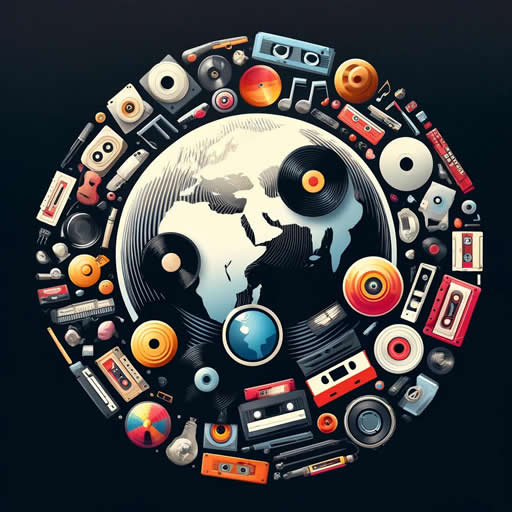The Impact of Digital Music on Collecting
In today’s digital age, the way we consume music has undergone a significant transformation. The shift from physical to digital formats has had a profound impact on various aspects of our lives, including collecting.
For generations, collectors have sought out rare and unique physical formats – vinyl records, CDs, cassette tapes, and more – to add to their collections. These physical items not only served as a means of enjoying music but also held sentimental value and became treasured possessions. However, with the rise of digital music, this way of collecting is rapidly becoming obsolete.
The Shift to Digital
The shift from physical to digital music formats is undeniable. According to a report by the International Federation of the Phonographic Industry (IFPI), the global recorded music market grew by 9% in 2020, with digital music sales accounting for 79% of total revenues.
This trend is expected to continue, as more and more people turn to streaming services for their music needs. The convenience and accessibility offered by digital music have made it easier than ever to discover new artists and genres, as well as explore different eras and styles.
Digital platforms like Spotify, Apple Music, and Amazon Music allow users to access their entire music library from anywhere, at any time, without the need for physical storage space. This has led to a significant increase in music consumption, with users able to enjoy high-quality audio formats, lyrics displays, and artist interviews.
Impact on Collectors
The shift from physical to digital music has had a significant impact on collectors. Many enthusiasts who have spent years building their collections are now struggling to adapt to the changing landscape.
For some, the loss of physical formats is a blow to their sense of nostalgia and emotional connection with their music. The sentimental value attached to these physical items has been replaced by the convenience and accessibility offered by digital music.
However, others see this shift as an opportunity to explore new ways of collecting and experiencing music. Digital platforms like Discogs and MusicStack allow users to build virtual collections, share them with friends, and even monetize their rare and unique digital items.
This has created a whole new community of collectors who are passionate about music and eager to connect with others who share their interests. The ability to trade and collect digital music has opened up new possibilities for enthusiasts to share and discover new music.
The Changing Value of Physical Formats
As digital music becomes more prevalent, the demand for physical formats like vinyl records and CDs has decreased. This has led to a surplus in the market, making it easier than ever to find rare and unique items at affordable prices.
However, this also means that the value of these physical formats is decreasing, making them less desirable as collectibles. The decline in demand has resulted in a decrease in their monetary value, making it harder for collectors to sell or trade these items.
The Future of Collecting
As we look to the future, it’s clear that the impact of digital music on collecting will continue to evolve. Emerging technologies like blockchain and AI are creating new opportunities for collectors to buy, sell, and trade their favourite music in a secure and transparent manner.
Platforms like Audius are using blockchain technology to create decentralised marketplaces where users can directly interact with each other without intermediaries. This has opened up new possibilities for collectors to discover and purchase rare and unique digital items.
The Resurgence of Physical Formats
While digital music remains dominant, there is a growing demand for unique and exclusive physical releases. Artists like Taylor Swift and Radiohead have already capitalized on this trend by releasing limited-edition vinyl records and CDs that come with special packaging and artwork.
This resurgence has led to a renewed interest in physical formats among collectors and fans alike. The tactile experience of holding a physical album or CD has been replaced by the convenience and accessibility offered by digital music, but the nostalgia and emotional connection attached to these physical items remain strong.
The Intersection of Collecting and Streaming
The intersection of collecting and streaming is becoming increasingly blurred. Platforms like Spotify and Apple Music are now incorporating features that allow users to build playlists, discover new artists, and even purchase music directly from their apps.
This has created a seamless experience for collectors who can access and enjoy their favourite music across multiple platforms. The ability to buy, sell, and trade digital music has opened up new possibilities for enthusiasts to share and discover new music.
Recommendations
If you’re interested in exploring the world of collecting, here are some recommendations:
* Start by building your digital music library using platforms like Spotify, Apple Music, or Amazon Music.
* Explore digital marketplaces like Discogs and MusicStack to discover rare and unique digital items.
* Consider purchasing physical formats like vinyl records or CDs from reputable sellers.
* Join online communities and forums to connect with other collectors and enthusiasts who share your interests.
The impact of digital music on collecting is undeniable. As we navigate this changing landscape, it’s essential to understand the shifting values and behaviours of music enthusiasts.
By embracing new technologies and formats, collectors can stay ahead of the curve and continue to build their passion for music. Whether you’re a seasoned collector or just starting out, there has never been a more exciting time to explore the world of collecting.
